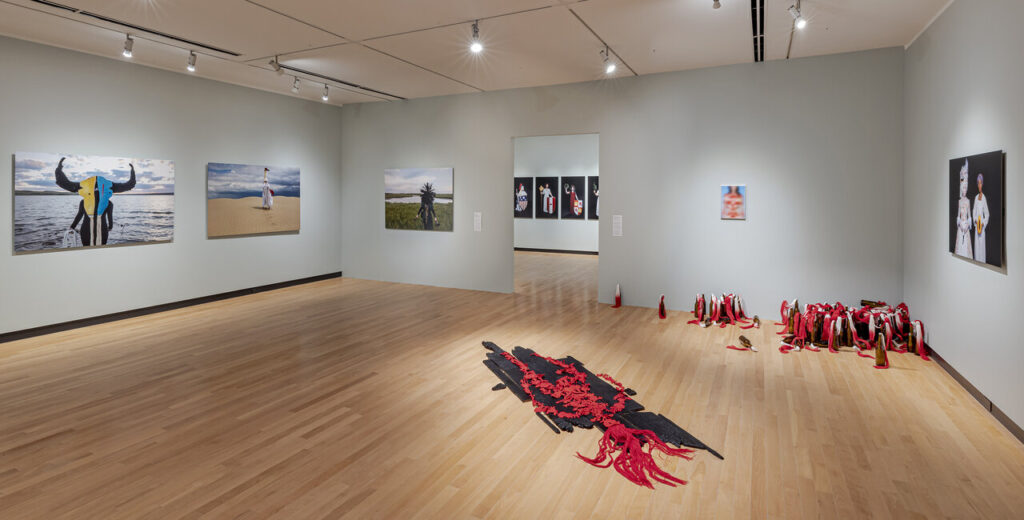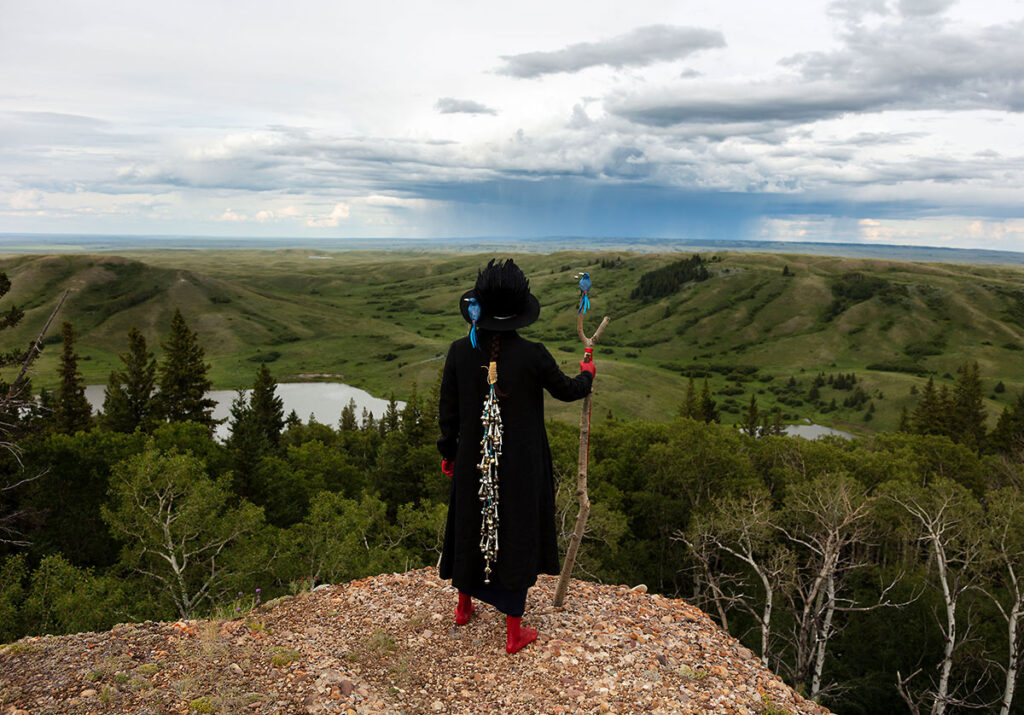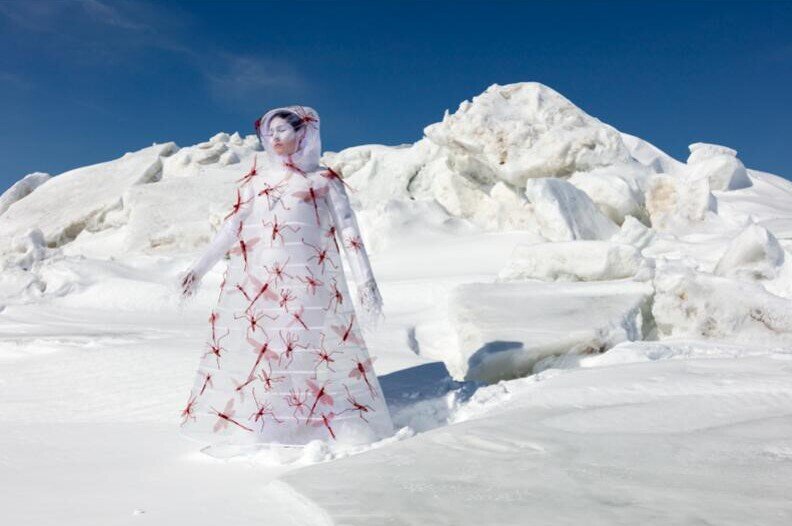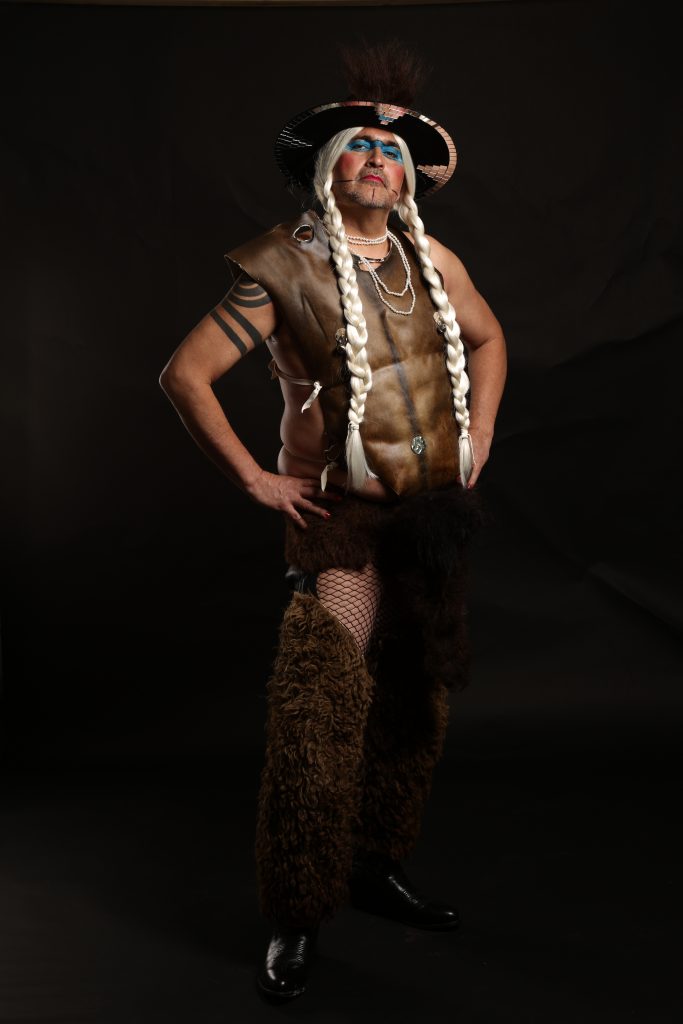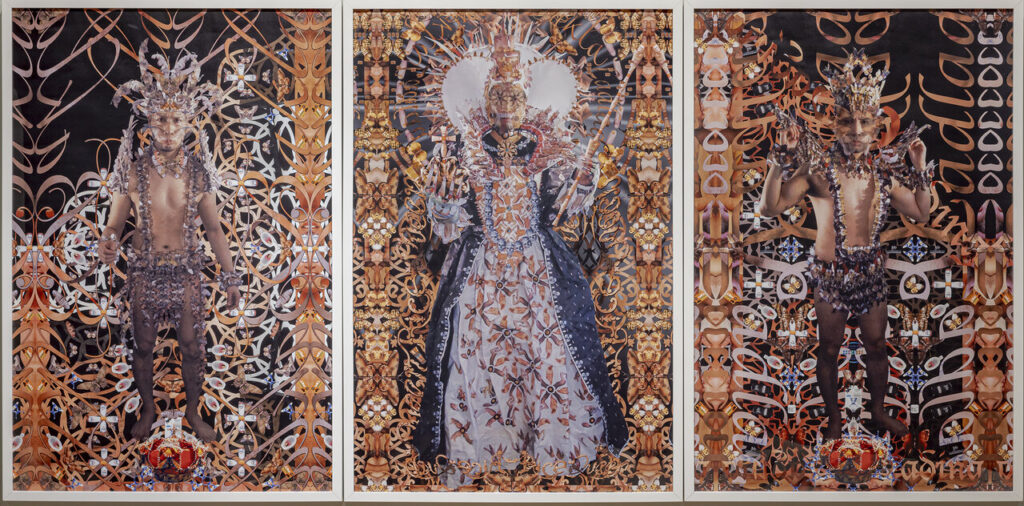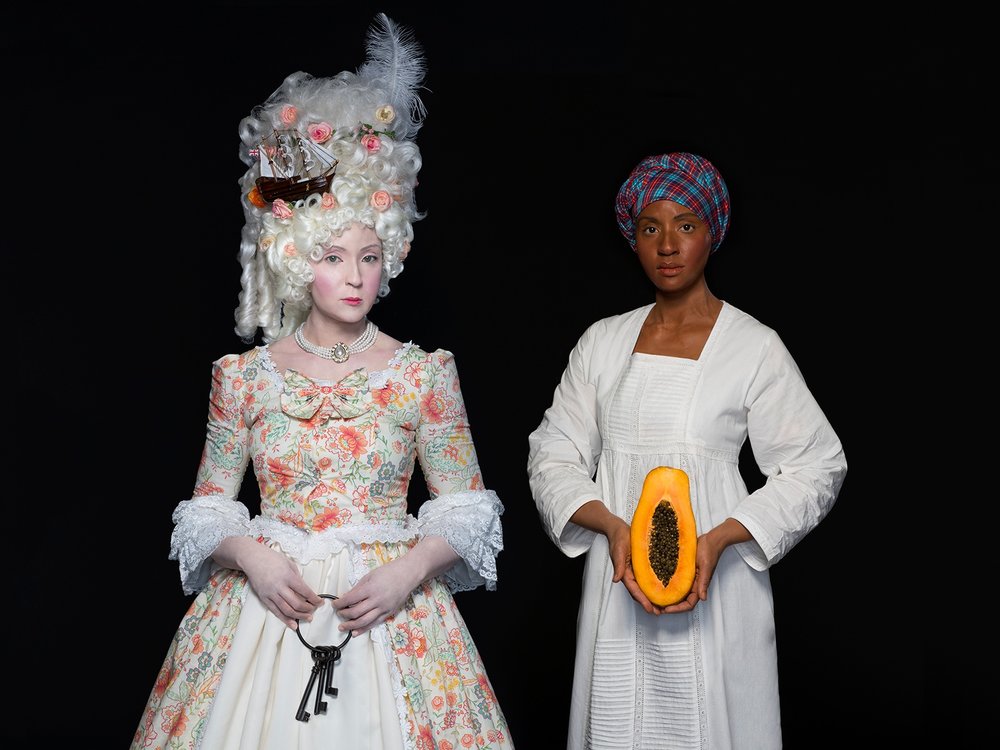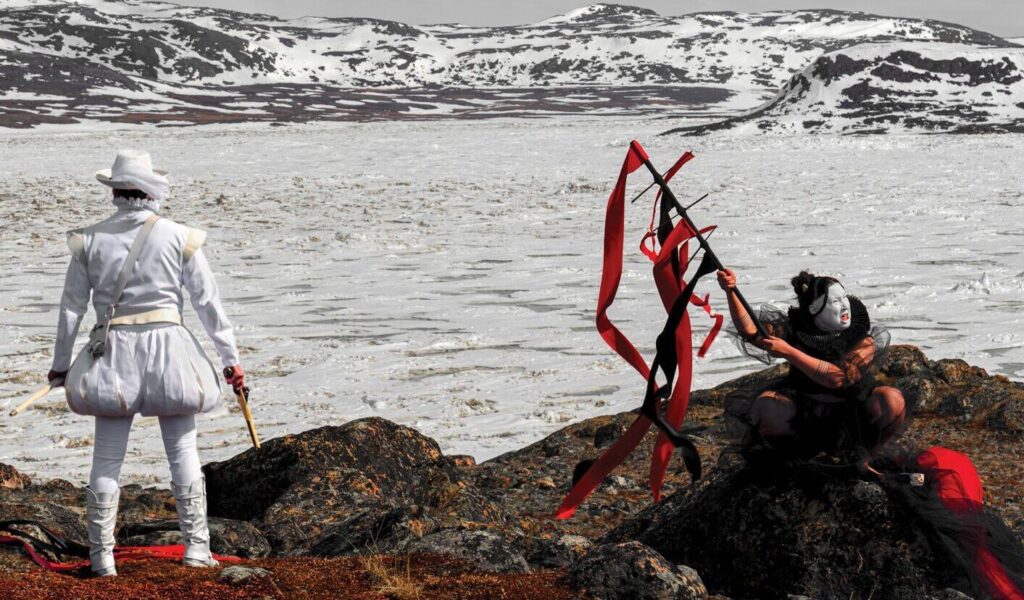The Counter/Self, the title of this exhibition, immediately captured my attention. I have always been interested in the hidden characters of people, including myself. We all have many faces and various personalities in addition to the one we consider our true self. It brings to mind Janus with his two faces in mythology and all the people through historical and contemporary times who often changed their personalities. As I have experienced myself, it can happen when we’re under social pressure, relocating, or trying to succeed in a society that has a different culture than the one we’re used to. Every self is performative and we also summon different characters to avoid conflict with others or to please them, as needed. Each of us express or hide our various sides of ourselves. Both social and personal identities are created by inner drives and external expectations that mirror our dreams and fears. There are also the masks we choose to put on intentionally to transfer us into another world or character. So, I thought this exhibition would offer endless possibilities in addressing this complex and exiting theme.
Installation view of THE COUNTER/SELF, Art Museum at the University of Toronto. Photo: Toni Hafkenscheid. Courtesy of the Art Museum at the University of Toronto.
In this exhibition at the Art Museum at the University of Toronto in its Justina M. Barnicke Gallery, Indigenous and diasporic Canadian artists analyze both national and personal identities by creating imaginative alter-egos with challenging narratives.
The first image we encounter is Meryl McMaster’s My Destiny is Entwined With Yours from the series As Immense as the Sky (2019), depicting a woman wearing shaman-like clothes in a grandiose landscape. Coming from a nêhiyaw (Plains Cree) and British/Dutch background, ancestral history is very important to McMaster and is the central theme of her photography. Each image is a contemplation on how one’s identity is formed. She traveled across Canada to site specific locations and made some research in order to re-experience ancestral stories learned from Elders, Knowledge Keepers within her Plains Cree community, family members, and friends. All of the images have a story to them, documenting the artist’s relationship with the natural world and the history written in the landscape. She admires the beauty of the land, listens to its wisdom but also fears for its future. In her explorations of the self, McMaster’s photographs reimagine many of the stories and traces left behind by different cultures.
Meryl McMaster, My Destiny is Entwined With Yours, from the series As Immense as the Sky, 2019, chromogenic print. Courtesy of the artist, Stephen Bulger Gallery and Pierre-François Ouellette art contemporain.
She often talks about the collapse of time into the present, while we often feel being outside of time when looking at her artwork. Her concept of time comes from two overlapping ideas. One is that time is a linear path that extends from the present in all directions, while the other one is recurrent and cyclical.
In the series As Immerse as the Sky, McMaster focuses on how the experience of time shapes the self’s connection to the immediate world. She creates dream-like images aiming to break down the barriers of time and space, picturing realities of collective history and the present, in new ways. Her image-making procedure starts with assuming a persona with a character and then playing out the story. All images are private performances, the artist’s responses to memory and to emotion. Landscape plays an important role as a dominant element in the composition as well as in creating the mood. The artist believes that the land holds more knowledge and power than we are able to see. Her pieces feel real as well as magical. Otherworldly figures populate the landscapes wearing mysterious sculptural attires. The created image is mythical and mystical at the same time. What Will I Say to the Sky and the Earth II (2019) is staged in a winter landscape where everything is covered by blindingly white snow, that is heavy, almost like stone. The sky is blue — one of McMasters favorite colors — and beautiful. The artist stands in a meditative pose, wearing a white garment and veils. Over her dress there are numerous red creatures that look like dragonflies and ants. Red is a powerful color and for McMaster it represents her ancestry and her responsibility to pass down the knowledge of the elders to the next generation. From where and how did these creatures get here? What do they represent? Are they bringing life into this frozen world or invading it? Putting it in some kind of danger? There are no answers for these questions from the artist as she seems to play a passive role. It seems like, as she said earlier, we have entered another dimension of time, where any kind of balance is possible.
Meryl McMaster, What Will I Say to the Sky and the Earth II, 2019, digital C-prints. Courtesy of the artist, Stephen Bulger Gallery, and Pierre-François Ouellette Contemporary Art.
Like McMaster, Adrian Stimson is also searching for his identity in his work. He is a member of the Siksika (Blackfoot) Nation in southern Alberta, Canada, and an interdisciplinary artist who exhibits internationally. His performance art examines identity, pinpointing how a strange mixture of the characteristics of the Indian, the cowboy and the shaman has been created and idealized. Buffalo Boy and The Shaman Exterminator are recurring personas in his mythology. In the Buffalo Boy performances, the artist fashioned his alter-ego Buffalo Boy (a play on the name Buffalo Bill) into someone totally different, in opposition to the colonial image of a ‘real’ Indian with feathers and buckskin, hunting buffaloes with spears. Stimson wants to change this stereotype and reprogram the Indian image. New Born Buffalo Boy (2022) is a product of his reprograming of the idea of the Indian, making it more open, and more contemporary with homoeroticism depicted with a great sense of humor. Stimson stands in poses of pride, wearing a strange mixture of traditional and modern outfits. In his images his face is painted with black paint around the chin mimicking Indian tattoos, his lips are red and he wears heavy blue make up around his eyes – giving him a woman’s provocative appearance. He wears a braided wig under a cowboy hat, a leather shirt and buffalo hide leg coverings as well as sexy stockings. In Buffalo Boy, Stimson creates a new person with mixed sexuality that contradicts both the traditional Indigenous and the colonial ideals, opening doors to a new reality where he is free to construct his own identity.
Adrian Stimson, New Born Buffalo Boy, 2022, performance still. Courtesy of the artist
Julius Poncelet Manapul also addresses sexual identity issues in his triptych, Whitewashed Bakla in the Presence of the Rice Queen (2017). The artwork, especially the two male figures on the sides, brings to mind Carnival in Rio de Janeiro, with its crowded composition, the use of masks and decorative ornamentation. The male figures’ outfits combine Indigenous Ifugao, Igorot and Ilocano attire designed from paper templates of butterflies, often used in the Philippines. Their faces are half covered by Asian masks. The Rice Queen in the middle reminds me of renaissance portraits of queens as well as sculptures of the Virgin Mary dressed for a religious procession, carried by singing believers. All the figures are paper cut-outs, framed by butterfly motifs combined with skin whitening products and gay porn elements. The references to Spanish culture are strong as the artist comes from a Filipino background, where the Spanish influence and domination is still present. Manapul’s works show the artist’s opposition to colonialism, European hegemony and sexual normativity.
Julius Poncelet Manapul, Whitewashed Bakla in the Presence of the Rice Queen, triptych, 2017, digital collage print. Courtesy of the artist.
Stacey Tyrell examines power, heritage and racial issues in post-colonial societies and the Caribbean diaspora. Mistress and Slave is a complex composition with personal and historical references. In this provocative image, Tyrell impersonates two historical women, Dido Elizabeth Belle Lindsay and her second cousin Lady Elizabeth Murray, who lived in 18th century England. Dido Belle was a mixed-race daughter of a British aristocrat, Sir John Lindsay, and an enslaved African woman in the West Indies, Maria Belle. Dido Belle grew up with her Murray cousins in England. Sounds like a happy ending. The pictured Lady Elizabeth and Dido Belle tells a somewhat different story, not that nice. The two young women stand side by side without looking at each other. There is no connection between them as they represent two different worlds. Lady Elizabeth is white and her appearance is an accurate depiction of British society norms at that time. She wears an intricate, rice-powdered wig with a boat, pearls and, more importantly, holds the keys of the household, symbolizing her power over everything and everyone in it. In strong contrast Dido Belle is a black person and appears in a simple white dress with a colored turban on her head. She seems more pure and much more natural than Lady Elizabeth. She holds half a papaya in her hands, a reference to her origins, that also reminds us of female genitalia. It is hard to guess her position in the household. Tyrell beautifully addresses racial issues and her dual (Canadian and Caribbean) ancestry in this artwork.
Stacey Tyrell, Mistress and Slaves, 2018, from Untitled series. Courtesy of the artist © Stacey Tyrell
Like in Tyrell’s work, power is a central element in White Liar and the Known Shore: Frobisher and the Queen (2021). This monumental and theatrical composition, is a collaborative artwork created by Laakkuluk Williamson Bathory (Inuk) and Jamie Griffith (Canada, UK), two multidisciplinary artists based in Iqaluit, Nunavut. In an almost unrealistic landscape, depicted in the winter in Nunavut, when the water is frozen and the mountains are covered by snow, two figures appear. Griffith adopts the persona of the English explorer Sir Martin Frobisher. He is the White Liar, wearing the white clothes of the Elizabethan era, holding a gun in his hand to symbolize his power and cruelty. He is standing with his back to us. Williamson Bathory impersonates Queen Elizabeth I with her famous white make-up that also refers to whitened bones, an Inuit symbol for respects to ancestors. Her dress somewhat mimics Elizabeth’s style, especially the collar but the red color could be associated with blood. She holds a red and black flag that originated in the Greenlandic mask dance. She is turned in the opposite direction from Frobisher. Her facial expression shows anger and fear, screaming into the distance. The entire composition gives me an uneasy feeling. The two figures are not related in any way. The color code is also worrisome, with the whiteness of the land and Frobisher’s clothes juxtaposed against the dominant red of the Queen. We can’t see Frobisher’s face as he looks at the empty, rigid land. There is no welcome from the land or the people. It is an isolated place with people who wanted to left alone. What does he want from this land? In reality, what he got was fool’s gold, a useless rock that the British mistook for real. Fortune seeking went wrong here but colonialization remained, causing the Indigenous people suffering in their own land historically and into the present.
Laakkuluk Williamson Bathory & Jamie Griffiths, White Liar and the Known Shore: Frobisher and the Queen, 2021, photography on stretched canvas. Courtesy of the artists.
The Counter/Self delivers a strong political message through very rich visuals. Communal histories depicted through the artists’ personal experiences create a dialogue about cultural legacies and social expectations, bringing up questions about our national narratives and power structures. The artists’ stories, being tragic or enigmatic — even flamboyant or whimsical — turn our attention to important, harmful and mostly unsolved issues about racism, colonialism and sexual orientation. It is an exhibition you need to visit more than once to fully understand its message.
Emese Krunák-Hajagos
*Exhibition information: The Counter/Self – a Group exhibition, curated by Mona Filip, January 11 – March 25, 2023, Museum of University of Toronto, Justina M. Barnicke Gallery, 7 Hart House Circle, Toronto. Museum hours: Tue, Thurs, Fri, Sat 12 – 5 pm, Wed 12 – 8 pm.

